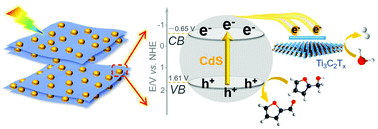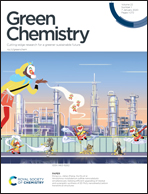Photoredox-catalyzed biomass intermediate conversion integrated with H2 production over Ti3C2Tx/CdS composites†
Abstract
Harvesting solar energy to drive highly efficient photocatalytic conversion of renewable biomass and its derivatives to value-added chemicals with the concomitant formation of hydrogen (H2) is a green and promising strategy to cope with the global energy dilemma. In this context, we have reported the facile assembly of uniformly distributed CdS nanoparticles (NPs) on the two-dimensional (2D) platform of Ti3C2Tx MXene nanosheets (NSs) via a low-temperature wet chemistry process, during which tight interfacial contact between CdS and Ti3C2Tx has been realized. The Ti3C2Tx/CdS composites feature remarkable enhancement in the aqueous-phase photoredox conversion of furfural alcohol to furfural and H2 by simultaneously utilizing photoexcited holes and electrons. Mechanistic studies reveal that the Ti3C2Tx MXene acts as an “electron sink” to capture the electrons generated from CdS and the close interfacial connection expedites the separation and transport of photoexcited charge carriers, thereby accelerating the photocatalytic performance of the Ti3C2Tx/CdS composites. We anticipate that this work would provide an instructive paradigm for further rational design of MXene/semiconductor hybrids for photoredox-catalyzed production of value-added products and H2 from biomass intermediates.



 Please wait while we load your content...
Please wait while we load your content...